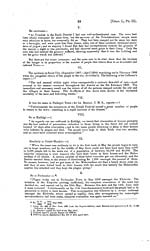Medicine - Disease > Bombay plague: being a history of the progress of plague in the Bombay presidency from September 1896 to June 1899
(53) Page 23
Download files
Individual page:
Thumbnail gallery: Grid view | List view

EVACUATION.] 23
IV.
The Acting Commissioner in Sind reports:-
"Gharibabad was the worst infected corner of New Sukkur, accounting for 106 cases of
plague in the three weeks ending the 19th April. On the 15th there had been 6 cases, on the
16th 6 cases, but on the 17th Mr. Lucas encircled them with a cordon of men of the Wiltshires,
and quietly removed the entire population of nearly 600 to the Health Camps, where next day
all were disinfected. Not another case occurred. The Camp inhabitants were free to go about
their business as usual, but most worked at their trades in the Camp. There was individual
medical inspection twice daily."
V.
He continues-
"Limji Charhi was another plague-infected quarter of small size, but giving 4 or 5 cases
'daily among only some 300 people. On the 26th April they were similarly moved and disin-
fected. The plague disappeared from that day."
VI.
The Collector of Surat reports:--*
"Asnabad-7 cases occurred between 16th and 26th February 1898. The result of
evacuation was successful as the occurrence of cases stopped after it. .The village was
re-occupied on 11th April 1898."
Other instances are Sukhpur and Mangra in Cutch, and Desur and Tamalwarilin Belgaum,
besides many others in other Districts.
It will be observed that in the case of evacuated towns, the disease appears to linger on for
weeks in a very slight form. This is due to the difficulty, after the people have been turned
out of a town or village, of preventing them surreptitiously visiting their houses ; and the fact
that it has been found to be an almost universal practice unfortunately vitiates to some
extent both the actual benefit of evacuation, and the figures of the epidemic of such town or
village, by making the duration longer and the figures larger than they would otherwise be.
The following instances illustrate the great risk people run who thus return to their houses,
even for the shortest space of time :- t
I.
Major Hyde Cates, Political Agent, Cutch, reports:-
"The village of Luni was evacuated in December (1897) and in the end of January
(1898) 4 persons of the village, with 3 relations, visited their houses without permission. All
of them got plague and four of them died."
II.
Mr. G. W. Hatch, I. C. S., Assistant Collector, Khandesh, reports the case of a Bannia
who returned to his house to get his money: sleeping on it for one night and taking it with him
to the Camp the next day. He was attacked with plague the day after his return to Camp,
and succumbed.
III.
In Kalol (Panch Mahals District) a tailor, by name Nansukh Narian, hearing that the floors
of the houses were to be dug up by the disinfecting parties, and afraid for his money, went
to his house secretly and remained in it all night, returning to the Camp the next morning with
his rupees. Two days later he died of plague.
IV.
Mr. H. F. Silcock, Acting Commissioner, N. D., late Collector of Nasik, writos-
". . it was a matter of common report in the Nasik District that the occasional cases which
occurred in Health Camps after evacuation were owing to the people stealing into their houses
at night to look after their property. There was one case at Malegaon reported to me, where
a Momin weaver, who had been for some time resident in the Health Camp, suddenly developed
plague, and it was found that he had been to his house in the town."
B. P.
Collector of Surat's No. B.P./1256 of 27th November 1899.
Memoraudum No. 57 of 12th January 1899.
Cited in Kalol Mmlatdr's report under Collector of Panch Mahls' No. 172, of 18th Janeary 1899; and
No. Police-1 of 12th January 1899.
Set display mode to: Large image | Zoom image | Transcription
Images and transcriptions on this page, including medium image downloads, may be used under the Creative Commons Attribution 4.0 International Licence unless otherwise stated. ![]()
| India Papers > Medicine - Disease > Bombay plague: being a history of the progress of plague in the Bombay presidency from September 1896 to June 1899 > (53) Page 23 |
|---|
| Permanent URL | https://digital.nls.uk/74586074 |
|---|




